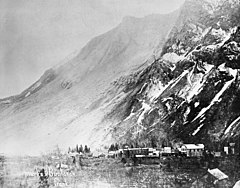Frank Slide

The town of Frank and Turtle Mountain on April 30, 1903, one day after the slide
|
|
| Time | 4:10 AM MST |
|---|---|
| Date | April 29, 1903 |
| Location | Frank, District of Alberta, Alberta (note) |
| Coordinates | 49°35′28″N 114°23′43″W / 49.59111°N 114.39528°WCoordinates: 49°35′28″N 114°23′43″W / 49.59111°N 114.39528°W |
| Deaths | 70–90+ |
| Website | www |
The Frank Slide was a rockslide that buried part of the mining town of Frank, Northwest Territories, Canada at 4:10 am on April 29, 1903. Over 82 million tonnes (90 million tons) of limestone rock slid down Turtle Mountain within 100 seconds, obliterating the eastern edge of Frank, the Canadian Pacific Railway line and the coal mine. It was one of the largest landslides in Canadian history and remains the deadliest, as between 70 and 90 of the town's residents were killed, most of whom remain buried in the rubble. Multiple factors led to the slide: Turtle Mountain's formation left it in a constant state of instability. Coal mining operations may have weakened the mountain's internal structure, as did a wet winter and cold snap on the night of the disaster.
The railway was repaired within three weeks and the mine was quickly reopened. The section of town closest to the mountain was relocated in 1911 amid fears that another slide was possible. The town's population nearly doubled its pre-slide population by 1906, but dwindled after the mine closed permanently in 1917. The community is now part of the Municipality of Crowsnest Pass in the Province of Alberta and has a population around 200. The site of the disaster, which remains nearly unchanged since the slide, is now a popular tourist destination. It has been designated a Provincial Historic Site of Alberta and is home to an interpretive centre that receives over 100,000 visitors annually.
The town of Frank was founded in the southwestern corner of the District of Alberta, a subdivision of the Northwest Territories in 1901. A location was chosen near the base of Turtle Mountain in the Crowsnest Pass, where coal had been discovered one year earlier. It was named after Henry Frank who, along with Samuel Gebo, owned the Canadian-American Coal and Coke Company, which operated the mine that the town was created to support. The pair celebrated the founding of the town on September 10, 1901, with a gala opening that featured speeches from territorial leaders, sporting events, a dinner and tours of the mine and planned layout for the community. The Canadian Pacific Railway (CPR) ran special trains that brought over 1,400 people from neighbouring communities to celebrate the event. By April 1903, the permanent population had reached 600, and the town featured a two-storey school and four hotels.
...
Wikipedia
